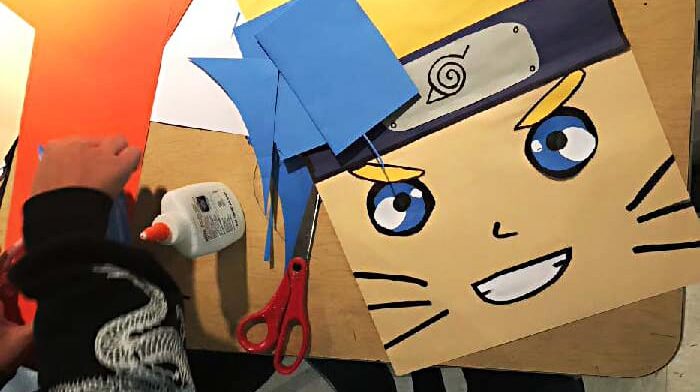One of the best ways I engage all learners is by promoting creativity in my art lessons. I will use a recent lesson I created (Collaborative Giant Nutcrackers) as an example of how I encouraged creative problem solving in planning an art lesson. After reading this post you will have 7 ways to incorporate creative problem solving in your lesson planning.
Present options for creativity in your art lessons
When possible allow students choice in mediums, tools, and/or subject matter. I gave my students the task to create a nutcracker collage. They had to use construction paper, but had choice in other art mediums or tools necessary to construct their collage. I label most cabinets and drawers in my classroom so students know they can use any medium available to them. Students used glitter, tape, glue, paper punches, brads, chalk, pastel, markers, etc. This asks them to consider the qualities of the materials and tools available so they can execute their plan most effectively.

Propose the lesson as a question
I often call my lessons “creativity challenges”. I ask a question or assign a task which requires a creative solution. For this lesson, I introduced students to the idea of a nutcracker and the anatomy of a nutcracker. Then I asked them “How can you make a collage that reflects your interests but still resembles a nutcracker?”
Provide time to plan
It is very important to allow time for students to plan and solve the problem you are asking. This allows students to really consider the medium and tools they need to execute the plan to their full potential. I asked my students to make a sketch and have their “plan” approved before beginning the construction of the nutcracker. It is also helpful to have students list the mediums and tools they will be using so you can discuss safety, clean up, etc. when you review the plan together.
Promoting creativity in art by creating a safe space to work
Create a culture of caring artists. I spend a lot of time at the beginning of the year letting students know they are safe from disrespectful comments about their artwork in my classroom. This allows students to feel the freedom to create anything without judgement from their peers or myself. Students also know they should not compare their artistic talents to others, instead look at personal growth.
Group work and collaboration
It makes me so happy to hear other students give suggestions or ask each other for advice. Students learn from each other, even if it is just sitting near one another in a cluster or group seating chart. In this collaborative lesson students worked in groups of two. Students learn to be open-minded when working with a partner and may take some risks in their artwork that they would not have done solo. Due to the scale of this lesson, it is a perfect collaborative lesson.
Setting goals and reflecting on experiences
Goal setting is an important part of the creative process. Students should be making realistic goals for themselves as artists. How can they challenge themselves in this lesson? My students make a goal for the lesson before starting and reflected on the lesson after completion. After creating the nutcracker collage students were asked to answer questions such as: how did you express yourself through the creation of your nutcracker.
I always stress the importance of “process over product”. What did you learn along the way and how can you apply your new knowledge to future artwork. My students know taking risks, being open-minded and reflective are very important traits of a growing artist.
Pop culture, humor and personal connections
Students will be more engaged when the subject matter interests them or when they can have fun with it. Who doesn’t love a big belly laugh, right? Encourage humor and parody when appropriate. Many of my students created nutcrackers inspired by pop culture, such as Steve from Minecraft, Thanos, Bart Simpson, and Naruto. Others students chose to highlight the music they listen to, cultural heritage, or just wanted to make a silly nutcracker. It is important to celebrate cultural differences and allow space for students to celebrate them. Nutcrackers do not have to relate to Christmas, with a little room for creativity we can also recognize different global holidays and the origins behind them, all of which leads to promoting creativity in art lessons. If you are interested in the Collaborative Nutcracker lesson plan click here.
For more ideas similar to this, check out my How to Motivate Art Students post.
Thanks for reading! – Trista
If you liked this post about promoting creativity in art lessons, please subscribe by clicking here.
Check out my How To Page for more posts like this.
Related Post: Collaborative Art Lesson Ideas








